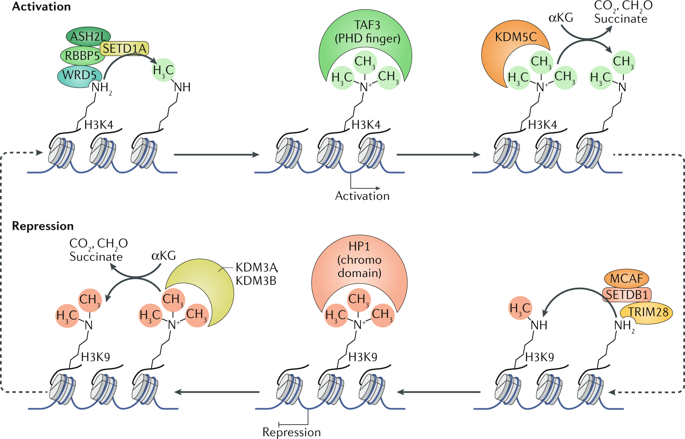当前位置:
X-MOL 学术
›
Nat. Rev. Mol. Cell Biol.
›
论文详情
Our official English website, www.x-mol.net, welcomes your
feedback! (Note: you will need to create a separate account there.)
Roles and regulation of histone methylation in animal development.
Nature Reviews Molecular Cell Biology ( IF 81.3 ) Pub Date : 2019-07-02 , DOI: 10.1038/s41580-019-0151-1 Ashwini Jambhekar 1, 2, 3 , Abhinav Dhall 1, 2 , Yang Shi 1, 2
Nature Reviews Molecular Cell Biology ( IF 81.3 ) Pub Date : 2019-07-02 , DOI: 10.1038/s41580-019-0151-1 Ashwini Jambhekar 1, 2, 3 , Abhinav Dhall 1, 2 , Yang Shi 1, 2
Affiliation

|
Histone methylation can occur at various sites in histone proteins, primarily on lysine and arginine residues, and it can be governed by multiple positive and negative regulators, even at a single site, to either activate or repress transcription. It is now apparent that histone methylation is critical for almost all stages of development, and its proper regulation is essential for ensuring the coordinated expression of gene networks that govern pluripotency, body patterning and differentiation along appropriate lineages and organogenesis. Notably, developmental histone methylation is highly dynamic. Early embryonic systems display unique histone methylation patterns, prominently including the presence of bivalent (both gene-activating and gene-repressive) marks at lineage-specific genes that resolve to monovalent marks during differentiation, which ensures that appropriate genes are expressed in each tissue type. Studies of the effects of methylation on embryonic stem cell pluripotency and differentiation have helped to elucidate the developmental roles of histone methylation. It has been revealed that methylation and demethylation of both activating and repressive marks are essential for establishing embryonic and extra-embryonic lineages, for ensuring gene dosage compensation via genomic imprinting and for establishing body patterning via HOX gene regulation. Not surprisingly, aberrant methylation during embryogenesis can lead to defects in body patterning and in the development of specific organs. Human genetic disorders arising from mutations in histone methylation regulators have revealed their important roles in the developing skeletal and nervous systems, and they highlight the overlapping and unique roles of different patterns of methylation in ensuring proper development.
中文翻译:

组蛋白甲基化在动物发育中的作用和调节。
组蛋白甲基化可发生在组蛋白中的多个位点,主要在赖氨酸和精氨酸残基上,并且它可以由多个正负调节剂控制,即使在单个位点也可以激活或抑制转录。现在很明显,组蛋白甲基化对于几乎所有的发育阶段都是至关重要的,其适当的调节对于确保控制多能性,机体模式以及沿适当谱系和器官发生的分化的基因网络的协调表达至关重要。值得注意的是,发育组蛋白甲基化是高度动态的。早期的胚胎系统显示出独特的组蛋白甲基化模式,主要包括沿袭特异性基因在分化过程中解析为单价标记的双价(基因激活和基因抑制)标记的存在,这样可以确保在每种组织类型中表达适当的基因。对甲基化对胚胎干细胞多能性和分化的影响的研究有助于阐明组蛋白甲基化的发展作用。已经发现,激活标记和抑制标记的甲基化和去甲基化对于建立胚胎和胚外谱系,通过基因组印迹确保基因剂量补偿以及通过HOX基因调控建立机体模式都是必不可少的。毫不奇怪,在胚胎发生过程中异常的甲基化会导致人体形态和特定器官发育的缺陷。由组蛋白甲基化调节剂突变引起的人类遗传疾病已经揭示了它们在骨骼和神经系统发育中的重要作用,
更新日期:2019-11-18
中文翻译:

组蛋白甲基化在动物发育中的作用和调节。
组蛋白甲基化可发生在组蛋白中的多个位点,主要在赖氨酸和精氨酸残基上,并且它可以由多个正负调节剂控制,即使在单个位点也可以激活或抑制转录。现在很明显,组蛋白甲基化对于几乎所有的发育阶段都是至关重要的,其适当的调节对于确保控制多能性,机体模式以及沿适当谱系和器官发生的分化的基因网络的协调表达至关重要。值得注意的是,发育组蛋白甲基化是高度动态的。早期的胚胎系统显示出独特的组蛋白甲基化模式,主要包括沿袭特异性基因在分化过程中解析为单价标记的双价(基因激活和基因抑制)标记的存在,这样可以确保在每种组织类型中表达适当的基因。对甲基化对胚胎干细胞多能性和分化的影响的研究有助于阐明组蛋白甲基化的发展作用。已经发现,激活标记和抑制标记的甲基化和去甲基化对于建立胚胎和胚外谱系,通过基因组印迹确保基因剂量补偿以及通过HOX基因调控建立机体模式都是必不可少的。毫不奇怪,在胚胎发生过程中异常的甲基化会导致人体形态和特定器官发育的缺陷。由组蛋白甲基化调节剂突变引起的人类遗传疾病已经揭示了它们在骨骼和神经系统发育中的重要作用,































 京公网安备 11010802027423号
京公网安备 11010802027423号